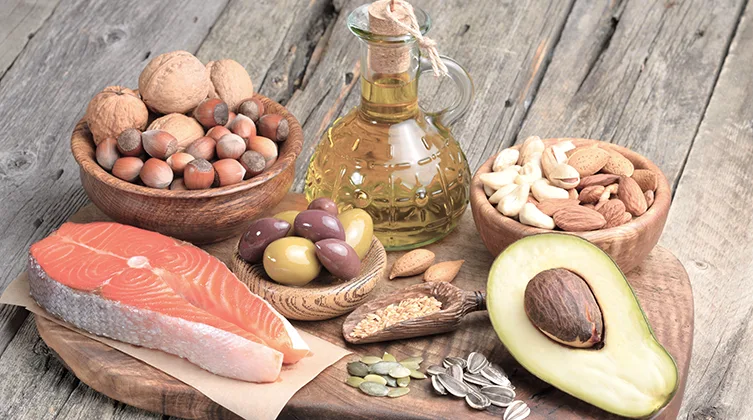FAT…
More commonly referred to as lipids in the scientific community, fat has taken a turn in recent years. It is no longer the great food demon that we once ostracised, feared and avoided. However, to fat or not to fat is a frivolous question. Fat is an essential component of our diet for the following reasons and more:
- Fats make up all the surfaces of our cells. They make them fluid and keep our body compartments balanced. When our cell walls lose their fluidity and become stiff problems can arise.
- Fats assist with delivering the wonderful fat-soluble vitamins, A, D, E, and K, to our bodies.
- Fats are required to synthesise and regulate many of our magical hormones including the sex hormones, adrenal hormones, as well as vitamin D (yes vitamin D is synthesised in the body, albeit in the presence of sunshine, and creates an essential hormone called calcitriol).
- The familiar omega-3 fatty acids found in seeds, such as chia and flax, are a type of fat.
- Fats comprise up to 60% of our brain tissue. The absurdly named fatty acids docosahexaenoic acid (DHA) and arachidonic acid (AA) are so essential for brain development that they are provided in abundance by the mother’s breastmilk to the rapidly developing infant.
- Fats play an important role in the eye.
- Fats help keep inflammation under control.
NOW WHAT ABOUT THE NOT SO GOOD ON FATS?
Fats supply the most concentrated form of energy or calories. Compared with the other energy-yielding nutrients, protein and carbohydrates, they provide more than double the amount of calories per gram.
It is therefore easier to exceed your daily energy requirements with the consumption of fats, which can then be stored as the more familiar type of body fat. The key is to choose your fats carefully and to consume them in delicate portions. Both the type and amount of fat consumed can influence weight and risk for disease. Read on for a list of the most nutritious, healthy fats to incorporate into your diet.
The key is to choose your fats carefully and to consume them in delicate portions.
THE DIRTY ON TRANS FATS.
Trans fats have been identified as the scapegoat for the previous assertions against saturated fats. Trans fats can occur naturally in some meats and dairy products, but more commonly they arise during the manufacturing process, which alters their chemical bonds and makes them harmfully reactive in the body. Trans fats have been linked to heart disease, undesirable cholesterol profiles, increased inflammation and insulin resistance. To lower your intake of these harmful fats, limit foods such as baked products, doughnuts, pastries, muffins, pies, biscuits, snack chips, deep-fried foods, margarine, vegetable shortening and vegetable oils.
A FAT BALANCING ACT.
The most talked about fat these days, omega-3, and its more abundant partner in crime, omega-6, deserve special mention. The balance of these two types of fats is important for great health. The preferable ratio is around 1:1 or 1:2. However, current estimates suggest that the western diet is around 1:16 or even higher! Omega-6 has become much more abundant in our food supply and our diets. The main source of omega-6 in our diets comes from vegetable oils (note, this does not imply they are derived from vegetables!), such as canola oil. Read the ingredients labels and you will find these oils are predominant in processed foods.
So why should we care? Well omega-3 and omega-6 fatty acids compete for the same enzyme. This enzyme helps convert the fats into their biologically active forms, which regulate inflammation. The omega-6 fatty acids are pro-inflammatory, whereas the omega-3 fatty acids are anti-inflammatory. Many of today’s chronic diseases have been linked to low-grade chronic inflammation. It’s easy to deduct and hypothesis that this fat balance plays a role.
The best way to improve your omega-3 to omega-6 ratio is to eat less processed foods, avoid vegetable oils and enjoy more high-quality sources of omega-3 fatty acids.
| Sources of omega-3 (want more) | Sources of omega-6 (want less) |
|---|---|
| • Raw nuts e.g. walnuts • Chia seeds • Fatty fish (salmon, herring, sardines) • Flaxseeds (linseeds) • Pumpkin seeds • Sunflower seeds |
• Vegetable oils (safflower, sunflower, cottonseed, canola) • Processed foods |
SO WHAT FOODS ARE RICHEST IN HEALTHY FATS?
The following foods are wonderful sources of healthy fats. They also contain other essential nutrients.
- Avocados
- Olives and olive oil
- Flaxseeds
- Chia seeds
- Walnuts
- Coconut
- Fish
Enjoy a healthy relationship with fat by nourishing and nurturing your body with high-quality, healthy sources.





